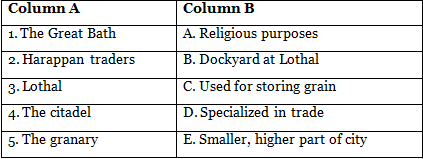Worksheet: Civilisation and Cities | Footprints Class 6: Book Solutions, Notes & Worksheets PDF Download
Q1: Multiple Choice Questions (MCQs)
(i) Who discovered the ruins of Harappa?
(a) Daya Ram Sahni
(b) Rakhaldas Banerji
(c) John Marshall
(ii) What was the largest building found in Mohenjodaro?
(a) A town hall
(b) A granary
(c) The citadel
(iii) Which of the following statements is not true for Mohenjodaro?
(a) Bricks were used for making buildings in Mohenjodaro.
(b) The citadel was a rectangular structure resembling a swimming pool.
(c) The city had a well-constructed drainage system.
(iv) The Harappan cities were divided into:
(a) The upper and the middle town.
(b) The town hall and the granary.
(c) The citadel and the lower town.
(v) The Harappan site in India that has a dockyard is:
(a) Ropar.
(b) Lothal.
(c) Rakhigarhi.
Q2: Fill in the Blanks
(i) The Harappan script has not been __________.
(ii) The drainage system of the Harappan cities was one of the best in __________ times.
(iii) Streets at Harappa were oriented from __________ to __________.
(iv) The Harappans likely worshipped trees and __________.
(v) The Harappan Civilisation lasted for about __________ years.
Q3: Match the Column
Match the items from Column A with the appropriate items from Column B:

Q4: True or False
(i) The Harappan script has been successfully deciphered.
(ii) Sindh and Rajasthan were deserts during the Harappan Civilisation.
(iii) The drainage system in the Harappan cities was poorly planned.
(iv) The Harappans likely worshipped only trees.
(v) The Harappan Civilisation lasted for about 500 years.
You can access the solutions to this worksheet here.
|
65 videos|127 docs|25 tests
|
FAQs on Worksheet: Civilisation and Cities - Footprints Class 6: Book Solutions, Notes & Worksheets
| 1. What are the main features of early civilizations? |  |
| 2. How did cities develop in ancient civilizations? |  |
| 3. What role did trade play in the growth of civilizations? |  |
| 4. What were some major ancient civilizations, and where were they located? |  |
| 5. How did the development of writing impact early civilizations? |  |















